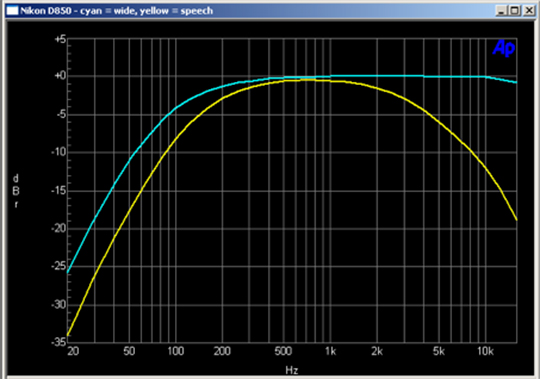
The article “Nikon D850 audio measurements” is by Otto Peter ( check also Otto’s previous guest post):
I recently upgraded from the D800 to the D850. Nikon has made so many lovely improvements, that I had high hopes for audio. Alas…
First problem: bad frequency response. As the D800 and the D4s, which I had measured before, the D850 mercilessly cuts off everything below 120Hz (-3dB cutoff frequency of a 2nd order highpass). To be totally clear, this is the “wide” setting. The only chance for a proper frequency response is to compensate in post, which is not straightforward with most audio editors. You cannot boost low frequencies before feeding the signal into the camera, as this would seriously over-drive the analog electronics. 19dB attenuation at 30Hz means that 9 times the voltage of a 1kHz signal is needed to get the same digital amplitude.
Here are the frequency responses of “wide” and “vocal” between 20Hz and 16kHz. They have been measured using a multi-tone signal (29 frequencies in the range of the graph) at the external microphone input, and have been normalized to 1kHz of the “wide” setting.
The second problem: clipping in the analog domain, before the signal is digitized, and well below digital full scale. The full digital range is never used, except in sensitivity settings 19 and 20, attenuator on. For a 1kHz sine signal, the maximum amplitude is about 3dB down from, or 71% of digital full scale in most settings, which corresponds to the top two bars (the red one plus one more) of the level indicator not lighting up. But with two bars dark, a 30Hz signal can already be clipped heavily, depending on sensitivity and attenuator settings. Due to that frequency dependence of the analog clipping limit as introduced by the aforementioned, analog high pass, it is not possible to use the level indicator to reliably prevent distortions.
I did not look at other aspects, like noise, total harmonic distortion, or automatic gain control. What I had seen so far somehow took the fun out of measuring the camera. I see that many people think that an external audio recorder is necessary for decent results, and I to agree. At least as long as camera manufacturers don’t fix their audio. Which would be easy. I asked Nikon customer support Germany about the crappy frequency response when I got the D800, and I asked them again now. Their answer in both cases: “this cannot be discussed, as it is not specified”. Go figure.
My recommendation for best noise performance when using an external preamp: Attenuator off, Sensitivity 1. The preamp has to be adjusted for
a maximum output voltage of 335mV RMS, or better for 474mV peak.
The long version: the noise floor at this setting is -86.5dBFS RMS relative to a digital full scale sine wave in my D850. The maximum input
amplitude at that setting before distortion (THD) exceeds 1% is -9.5dBV, or 335mV RMS for a sine wave, or 474mV peak, giving -1.2dBFS in the
digital domain at 1kHz (higher than what I saw with most settings). That results in a dynamic range of 85.3dB. The topmost/rightmost yellow bar
of the camera’s meter lights up at -11.25dBV at 1kHz. The red bar is useless. While the noise floor is lower if the attenuator is turned on,
the maximum digital amplitude is significantly lower, resulting in a lower dynamic range.
The 120Hz highpass filter will still have to be coped with, of course. At least, it also attenuates low frequency noise.
If you have an interesting idea for a guest post, you can contact me here.



